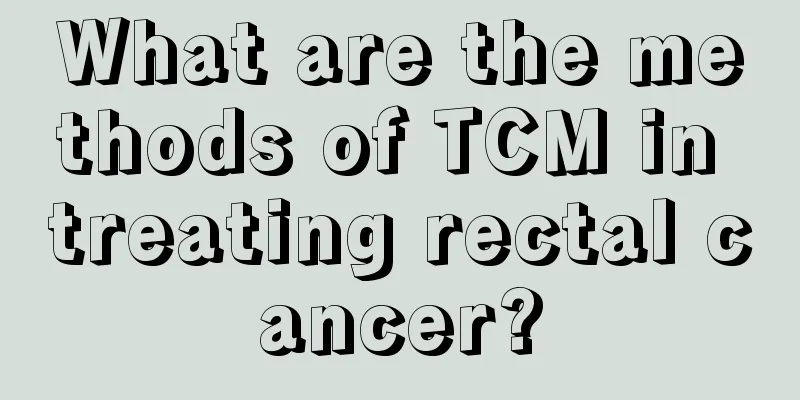Symptoms of colorectal cancer

|
There are no symptoms in the early stages of colorectal cancer, and by the time symptoms appear, it is no longer in the early stages. The common symptoms of colorectal cancer are as follows. (1) Changes in bowel habits: Changes in bowel habits refer to changes compared to the original. For example, if you used to have one bowel movement a day, it becomes two or more times a day, or if you used to have one bowel movement a week, it becomes once every two days. If you used to have dry stools, they become soft, shapeless or loose stools, or even mucus stools, mucus bloody stools or bloody stools. This is also a change in bowel habits. Changes in bowel habits are due to erosion and inflammation at the tumor site, and the secretions produced stimulate the intestinal wall to increase peristalsis. In some cases, the tumor causes narrowing of the intestinal cavity, which restricts the discharge of intestinal contents. However, when the accumulation reaches a certain amount, a large amount of intestinal contents are squeezed out with high pressure, causing diarrhea. Some patients think it is enteritis, which can be relieved after taking anti-infection drugs, but it will soon relapse, and the cycle is getting shorter and shorter. (2) Blood in stool: Blood in stool is an inherent symptom of colorectal cancer, but it is more likely to occur in cancers near the lower end such as the rectum, sigmoid colon and descending colon. Depending on the different pathological bases such as local erosion, ulceration, combined infection and bleeding, mucus stool, mucus blood stool, blood stool or pus and blood stool may appear. At this time, it is often mistaken for dysentery. Sometimes, it can be relieved by controlling the infection to a certain extent, so it is more likely to be dysentery. At this time, a digital rectal examination is very meaningful. If blood in stool occurs in rectal cancer, blood may drip after defecation, which can be easily mistaken for internal hemorrhoids: bleeding in the sigmoid colon and descending colon often shows blood attached to the stool, which is bright in color, while bleeding in intestinal cancer above the transverse colon is mostly blood mixed with stool, which is dark brown, black, or tarry in color. At this time, the stool is unformed due to the increased intestinal peristalsis. (3) Abdominal pain: Abdominal pain is caused by increased intestinal peristalsis. It may be dull pain at first, gradually worsening to paroxysmal pain. The pain may be relieved or stop after defecation. Advanced rectal cancer may manifest as a feeling of falling in the anus or lower abdomen. (4) Abdominal masses: Abdominal masses are mostly caused by intestinal cancer causing varying degrees of intestinal obstruction. Intestinal contents accumulate in the intestinal cavity above the obstruction, often accompanied by abdominal pain. In late-stage cecal cancer and sigmoid colon cancer, a fist-sized mass may also be felt. (5) Anemia: Tumor consumption and reduced intake can lead to anemia, especially in right-sided colon cancer. Anemia may be the first symptom, so be vigilant. |
<<: Metastatic pathways of esophageal cancer
>>: Traditional Chinese medicine treatment for liver cancer
Recommend
Symptoms of heartburn
On TV, we often see a weak woman holding her ches...
How to brush your teeth with baking soda
In today's life, everyone has very high requi...
What are the taboos of the effects of Butterfly Brand
Many people may not know about the Butterfly amul...
What medicine should I take to prevent metastasis of nasopharyngeal carcinoma
Because the incidence of nasopharyngeal cancer is...
What is ferrous sulfate
Sulfuric acid and iron are two things we can actu...
Can allergic skin be cured?
Allergic skin is a relatively common skin disease...
How to exercise back muscles
For office workers, their muscles are very thin c...
What is the reason for numbness in toes
If you want to effectively treat numbness in your...
What causes a hard lump on the back of my hand?
The role of hands is so important. Hands can do s...
How to treat hereditary allergic dermatitis?
In today's era, many young couples want to be...
What to do with the pain of bone cancer
What should we do with the pain of bone cancer? P...
The difference between Judo and Taekwondo
Judo and Taekwondo are now popular fighting techn...
Symptoms of deficiency of the five internal organs
When problems occur in the organs inside the body...
How to take better care of dry and frizzy hair
Our hair represents the whole image of a person. ...
What are the early symptoms of colon cancer
Transverse colon cancer is rare and easy to misdi...









